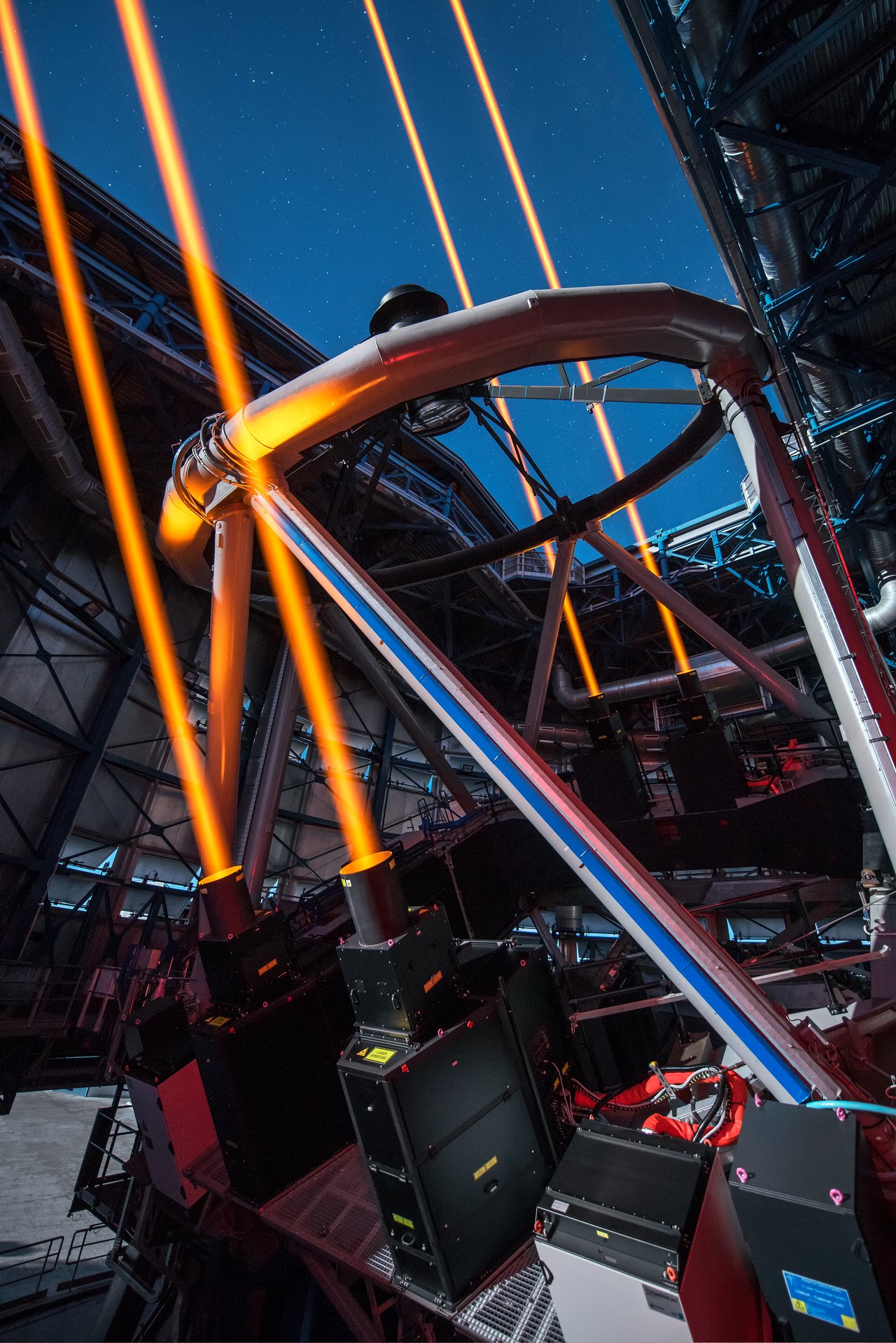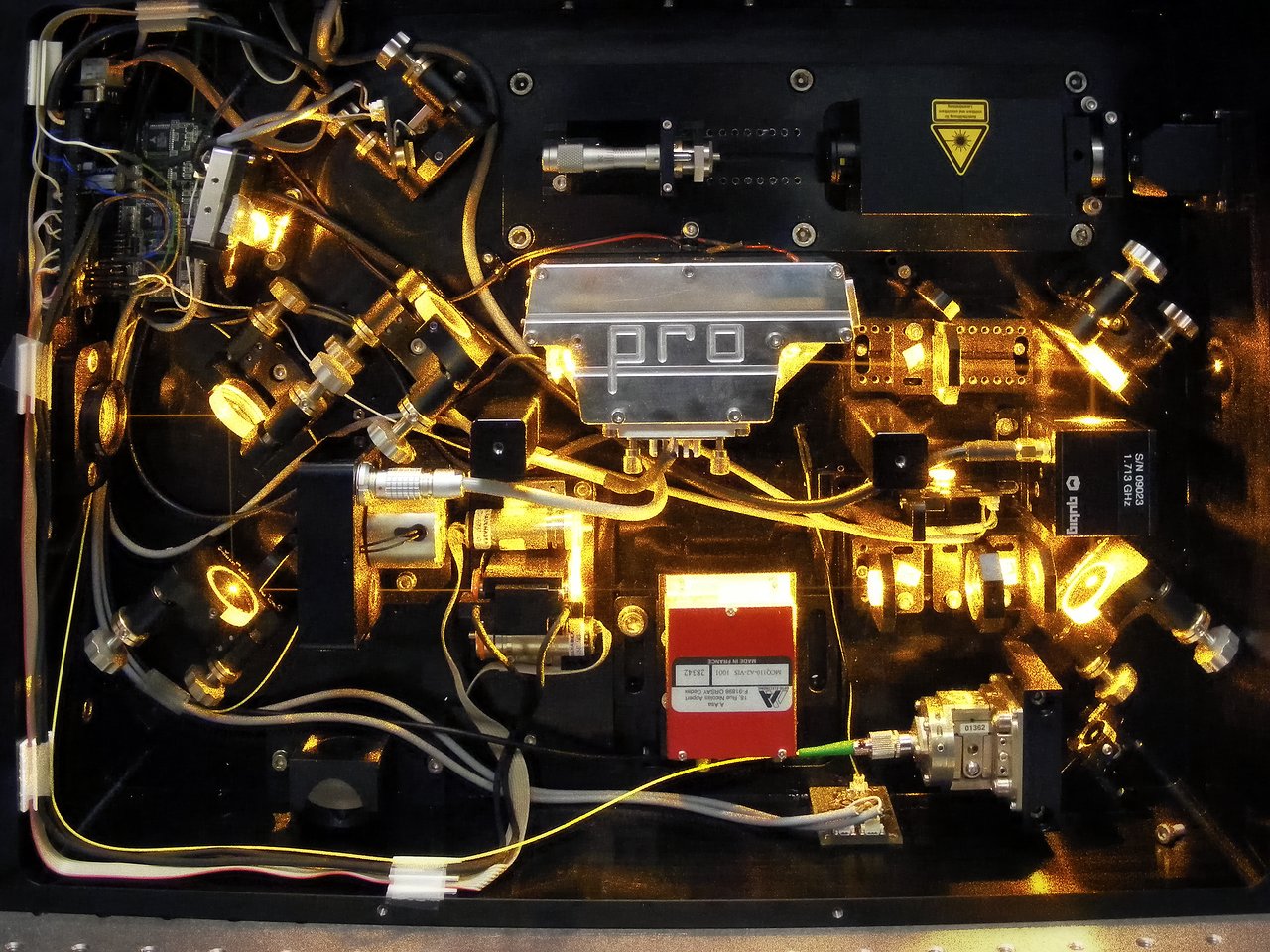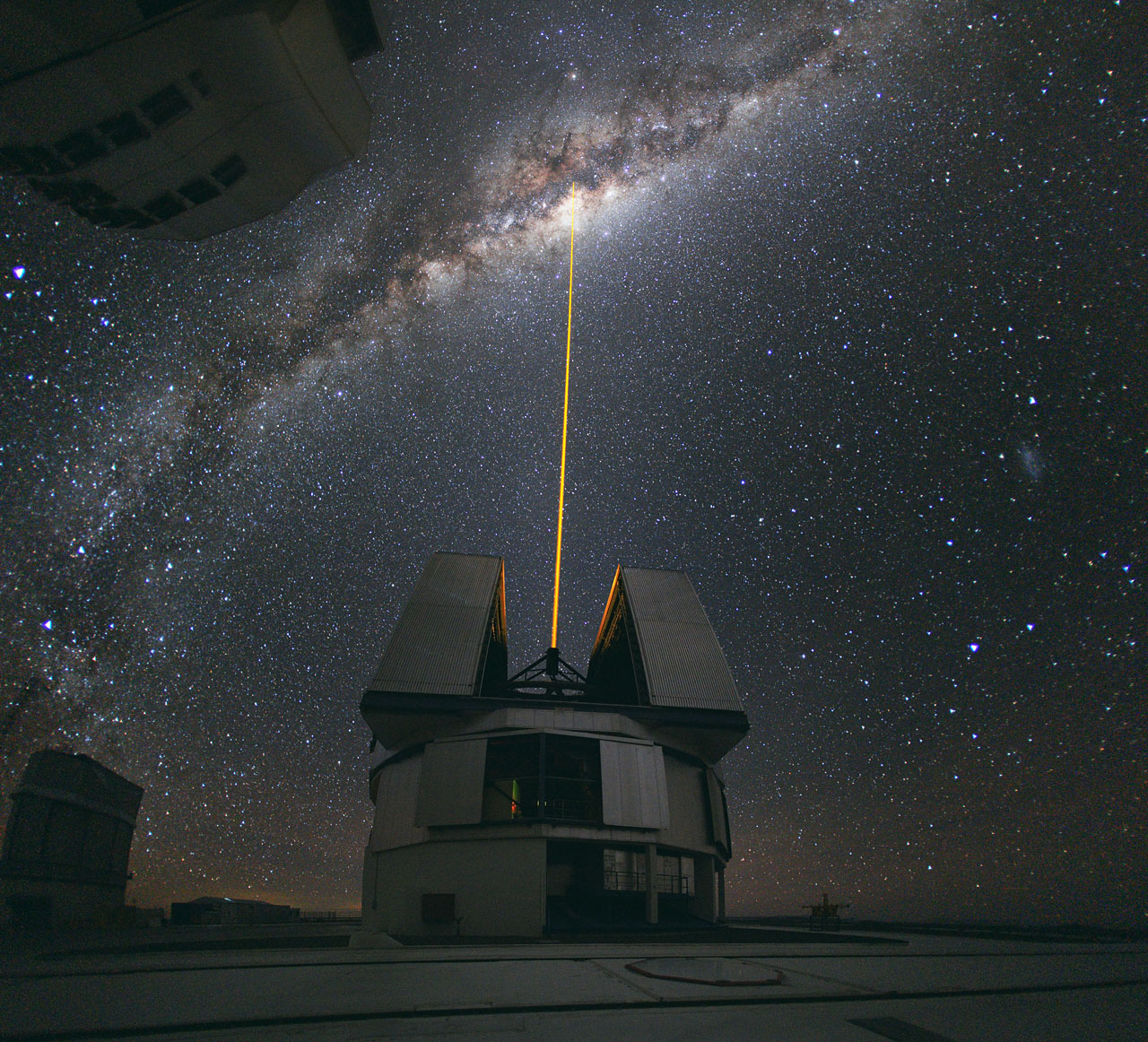
Making Laser Guide Stars Even Brighter
ESO physicist Domenico Bonaccini Calia tells us about newly-developed laser technology
- Why adaptive optics systems are vital to modern astronomy
- What ESO is doing on the frontline of laser guide star research
- How such systems can be applied in upcoming telescope projects like the ELT
Q: Domenico, could you briefly explain why laser guide star systems are important to astronomers?
A: Laser guide stars are used together with adaptive optics, the technology that helps astronomers to compensate for the atmospheric turbulence that affects the images of ground-based observations. An artificial guide star is produced by shining a powerful laser into the sky and exciting sodium atoms in the mesosphere (about 90 kilometres up in the atmosphere). This “star” acts as a reference point that allows adaptive optics to measure and compensate for the turbulence. This means that instruments can create crisp images of astronomical objects as sharp as if the telescope were in space, which is a tremendous advantage.
Q: What kinds of laser guide star systems does ESO currently employ on its telescope?
A: Our most advanced lasers have been the outcome of ESO internal research and development, which went on to be patented and engineered by two of our industrial partners, TOPTICA Photonics and MPB Communications. We’ve worked closely with these two partners over the past years to develop the final, extremely well-engineered, deployable laser, starting from our prototyping work.
This is, for example, the type of laser system used on the Very Large Telescope’s cutting-edge Unit Telescope 4. The system consists of a specially-designed 22-watt laser, operating at a wavelength of 598 nanometres with an emission linewidth of about 0.000003 nanometres (equivalent to a frequency of 2 MHz). This creates a laser guide star that allows the adaptive optics system to measure the image distortion created by the turbulence of the atmosphere, 1000 times per second. From these measurements, the fast deformable mirror of the adaptive optics system can adjust its shape to correct for the distortions and hence make the images sharper.
Essentially, these are compact laser guide star units, where small, powerful lasers are combined with a telescope system that launches the beam — and this means that the modular unit can be mounted directly onto an existing telescope, to produce one laser guide star per module.
The TOPTICA–MPBC lasers are a great development and are becoming a standard for astronomical observatories — the laser is turn-key, can be remotely operated, and is rugged enough to endure the harsh conditions such as temperature variations and the shigh altitude in the Atacama Desert in Chile. This is why we have also ordered them for ESO’s future Extremely Large Telescope. We received the prestigious Leibinger Innovation Award for this laser development with industry.
Q: Tell us about the new laser field tests being conducted by ESO now.
A: Along with institutes from ESO Member States, we are currently using the 20 watt Continuous Wave laser — which was produced during our development — to test various technologies related to laser guide star systems.
We are using the ESO Wendelstein Laser Guide Star Unit placed 40 metres from the 4.2-m William Herschel Telescope, at the Observatorio del Roque de los Muchachos, on the island of La Palma in Spain’s Canary Islands. The Wendelstein laser was developed at ESO’s laser labs in the years 2005–2009. It uses the same technologies as those licensed later in 2010 to TOPTICA and MPBC for the production of our engineered lasers: it uses a powerful 20 watt yellow beam (operating at 589 nm) to make sodium atoms in the Earth’s mesosphere glow, producing a laser guide star 90 km above ground.

The tests we are conducting now are strategic; they will help us see the direction of technological developments needed for future, better laser guide star adaptive optics systems — aimed specifically at the next generation of telescopes and instruments.
To conduct these tests, an even more powerful 589-nm laser is being built at our labs, in collaboration with industry.
One of the important goals of our research and development is to find a way to make the laser guide star even brighter. It is a very complex problem, linked with the mesospheric environment, atomic physics and quantum theory. In the past, we’ve done experiments on different parameters of the laser emission, and right now we’re working to experimentally evaluate a method known as “frequency chirping”. Essentially, this means that the laser’s emission frequency is changing repeatedly and periodically, to follow the recoil of the sodium atoms induced by their interaction with the laser.
From our models of sodium atom interactions, frequency chirping should improve the laser guide star’s brightness by a factor at least 1.5. This means more return photons for the same laser power.
Q: Can you explain why frequency chirping would increase the brightness?
A: The short answer is that frequency chirping optimises the number of sodium atoms that are able to interact with the laser photons. This means that the artificial “star” will shine brighter. The technique we want to apply is a modification of the atomic Doppler cooling, used in atomic physics.
The long answer is a bit more complex and depends on the detailed atomic physics of the sodium layer. Ready for some high-level physics?
When a sodium atom is hit by our laser beam, it absorbs and re-emits the photons, which causes a “recoil” of the atom. This means that each time it emits a photon toward us on the ground, the atom increases its relative velocity with respect to us. Because of the Doppler effect, its resonant frequencies seen from the ground shift by a tiny amount for each photon emission — 0.000000057 nm (equivalent to about 50 kHz). After a number of absorptions and re-emissions, the laser photons can no longer interact with that atom because the continued recoil has given the atom a resonant wavelength out of the 0.000003 nm laser line emission (about 2 MHz). This is called “spectral hole burning”.
The sodium atoms that have interacted with the laser have therefore acquired a different velocity. This means these atoms require a slightly different laser line wavelength to be excited again.
If we change the wavelength of the laser accordingly, we can actually follow the atoms into their next velocity class. Here, more atoms are present that weren’t interacting with the laser before, so the total number of atoms interacting with the laser increases — i.e., the laser guide star becomes brighter. This is a sort of snowplowing, varying the laser wavelength and using the atomic recoil, to move the recoiling atoms across different velocity classes and accumulating their number in the process.
For the mesosphere, we calculate that on average, the atomic collisions will reset the atomic velocities about once every 150–200 microseconds. So we derive that the laser photons wavelength should be varied by up to 0.000231 nm (200 MHz), in a sawtooth manner with a period of 0.142 milliseconds. So we shift (sweep) the laser emission line progressively 7000 times per second, going back and forth in the photons vibration frequencies. These values will have to be verified and optimised experimentally during the tests.
After testing in the lab at ESO, we will do sky tests at the La Palma site, where we’ll monitor the return flux — i.e., how bright the laser guide star is — while toggling between chirping and no chirping and exploring the optimal settings (in particular, changing the speed and range of the frequency shift).
For more in-depth details about how we make the lasers “chirp” in this way, please visit our webpage. It gets fairly technical!

Q: How will this new technology help us to improve observations, with telescopes from ESO and other institutions?
A: If we demonstrate that the laser frequency chirping gives us brighter laser guide stars, it could be implemented on new (or retrofitted in existing) lasers for laser guide stars. For the same laser power, we will obtain brighter laser guide stars!
This has benefits for the operation of all laser guide star Adaptive Optics systems existing or being built in the world, giving a stronger reference signal for adaptive optics, allowing operation of the instruments when observing closer to the horizon, or when the mesospheric sodium abundance (which varies) is at its minimum.
Q: Is there anything else you would like to add?
A: I thank you for this interview. I very much enjoy the work and the activities at ESO — I am honoured to be involved. I find it exciting to work on a mixture of innovative ideas, coming from the constant progress in photonics technologies, the knowledge of astrophysics instrumentation needs, and the experimental work.
None of this would have been possible without the dedicated, intelligent work of my colleagues in various departments, the contribution of brilliant students, and the encouraging support and trust of the ESO management across the years, up to today.
The success of our work at ESO for the adaptive optics community is also due to the collaborative spirit and professional engagement of research groups outside ESO. Among others, the Adaptive Optics groups at Durham University (UK), the Observatoire de Paris (F), the Instituto Astrofisico de Canarias (ES), the Max Planck Institut für Extraterrestrische Physik (D) and the Istituto Nazionale di Astrofisica (I), with the groups at Osservatorio di Roma and at Osservatorio di Arcetri.
Numbers in this article
|
0.000231 |
Range of the shift in wavelength (nanometres) during the laser frequency chirping |
|
7000 |
Number of chirp wavelength range sweeps per second |
| 40 | The ESO Wendelstein Laser Guide Star Unit is placed at 40 metres from the 4.2-m William Herschel Telescope, at the Observatorio del Roque de los Muchachos. |
|
598.1591 |
The exact wavelength (in nanometres) at which the lasers of the laser guide star systems operate |
|
1000 |
Using an artificial star, the laser guide star system can measure the image distortion created by the turbulence of the atmosphere 1000 times per second. |
Links
- Find out more about this research on the Laser Guide Star Developments webpage
- Laser Development for Sodium Laser Guide Stars at ESO: Article in The Messenger
- Read more about the VLT UT4’s adaptive optics system
- Read more about TOPTICA Photonics laser guide star systems
Biography Domenico Bonaccini Calia
Domenico Bonaccini Calia has been working as a physicist at ESO for over 23 years. He obtained his Masters in physics at the University of Florence, Italy, then completed a PhD in astrophysics and a postdoc period at the Sac Peak National Solar Observatory in New Mexico, USA. On his return to Italy, Domenico held a staff position at the Arcetri Astrophysical Observatory, in Florence, where he created the adaptive optics group in 1990, before moving to ESO, Germany, in 1995.
At ESO he worked in the adaptive optics group and in 2000 he has created the Laser Guide Star Systems Department, serving as Head of Department until 2010. He has contributed to two laser guide star facilities now installed on the VLT, and is currently responsible for the laser guide star Systems Research and Development activities at ESO, under the Technology Development program.
D. Bonaccini Calia has received in 2017 the Optical Society of America Fellow Award, for the contribution to the progress of photonics in astronomical instrumentation.




